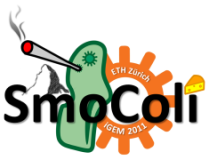Team:ETH Zurich/Overview/Project
From 2011.igem.org
(Difference between revisions)
(→Project description) |
(→Project description) |
||
| Line 10: | Line 10: | ||
| | | | ||
= Project description = | = Project description = | ||
| - | [[File:ETH SmoColi.png|350px|right|thumb|Visual output of the SmoColi smoke detector device. For low and medium acetaldehyde or xylene concentrations (lower three sub-images) a green stripe is indicating the concentration of the toxic molecules. If the concentration is above a critical threshold, a red alarm signal is triggered (upper sub-image).]] | + | [[File:ETH SmoColi.png|350px|right|thumb|'''Visual output of the SmoColi smoke detector device.''' For low and medium acetaldehyde or xylene concentrations (lower three sub-images) a green stripe is indicating the concentration of the toxic molecules. If the concentration is above a critical threshold, a red alarm signal is triggered (upper sub-image).]] |
We engineered two gas induced systems in ''E.coli'', such that our cells can either detect acetaldehyde or xylene, both being toxic substances found in cigarette smoke. | We engineered two gas induced systems in ''E.coli'', such that our cells can either detect acetaldehyde or xylene, both being toxic substances found in cigarette smoke. | ||
Revision as of 22:56, 21 September 2011
| Project Idea |
|
Our project focuses on the detection of cigarette smoke in the air. Our SmoColi cells detect two different toxic substances contained in cigarette smoke, acetaldehyde and xylene, and display their concentrations visually by display of a spatially varying, fluorescent light output signal. Depending on the interpretation, SmoColi can thus either serve as a health assistant device, warning of dangerous smoke concentrations in the air, or as a “partymeter”, monitoring the progress of a certain party (under the creative assumption that the progress of the party is measured by the amount of smoke in the air). |
 "
"


